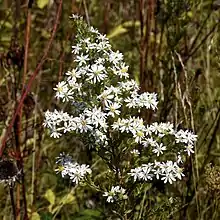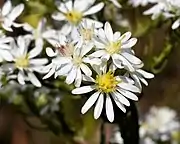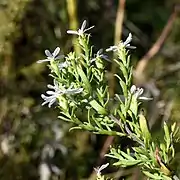Symphyotrichum ericoides
Symphyotrichum ericoides (syn. Aster ericoides), known as white heath aster,[3] frost aster,[4] or heath aster,[5] is a species of flowering plant in the family Asteraceae, native to much of central and eastern North America. It has also been introduced to parts of Europe and western Asia.[2]
| Symphyotrichum ericoides | |
|---|---|
 | |
| Scientific classification | |
| Kingdom: | Plantae |
| Clade: | Tracheophytes |
| Clade: | Angiosperms |
| Clade: | Eudicots |
| Clade: | Asterids |
| Order: | Asterales |
| Family: | Asteraceae |
| Genus: | Symphyotrichum |
| Subgenus: | Symphyotrichum subg. Symphyotrichum |
| Section: | Symphyotrichum sect. Symphyotrichum |
| Species: | S. ericoides |
| Binomial name | |
| Symphyotrichum ericoides | |
| Synonyms[2] | |
|
Selected synonyms include:
| |
Description
Heath aster is a perennial herbaceous plant with stems from 1 to 3 ft (0.3 to 0.9 m) tall.[5] Its leaves are sessile (stalkless) and narrow, becoming smaller towards the top of the plant and tips of the branching stem. It has white (rarely pinkish), composite flowerheads with yellow centers that begin flowering in late summer through fall.[6][7] They are rather small, 1⁄3 to 1⁄2 inch (8 to 10 mm) across.[5][4]
It is commonly confused with Symphyotrichum pilosum, which co-occurs throughout most of its range.[6][8][9] S. pilosum has larger flowerheads with longer ray petals. The phyllaries on S. pilosum are spine-tipped, while those of S. ericoides are not (although the curled edges may make them appear to be).[6]
 Close-up of the flowers
Close-up of the flowers Bracts
Bracts
Taxonomy
Heath aster has two varieties: Symphyotrichum ericoides var. ericoides, which spreads by underground rhizomes to form colonies, and S. ericoides var. pansum, which is cespitose, remaining in a clump, and has corm-like caudices.[10][11]
Distribution and habitat
Heath aster grows from Canada across much of the United States into the Mexican states of Coahuila and Nuevo León.[6] The variety S. ericoides var. ericoides prefers open locations with sandy, gravelly, or disturbed soil.[10]
Cultivation
Confusingly, plants sold in the horticultural trade labeled as Aster ericoides, the old name of the plant, are almost invariably cultivars or hybrids involving the species Symphyotrichum dumosum, S. lateriflorum, S. pilosum or S. racemosum, a mistake that has apparently occurred continuously since the 19th century.[6]
Asters are tough plants, though they can be subject to fungal infections, especially if not planted in open, sunny conditions where the soil is not too damp. They are valued in the garden for providing late season flower colour in shades of blue, pink and white. The following cultivars of A. ericoides have gained the Royal Horticultural Society's Award of Garden Merit:[12]
References
- "Symphyotrichum ericoides". NatureServe Explorer. NatureServe. Retrieved 2007-07-04.
- "Symphyotrichum ericoides (L.) G.L.Nesom". Plants of the World Online. Royal Botanic Gardens, Kew. Retrieved 17 October 2020.
- "Symphyotrichum ericoides". Natural Resources Conservation Service PLANTS Database. USDA. Retrieved 17 October 2020.
- Hilty, John (2016). "Heath Aster (Symphyotrichum ericoides)". Illinois Wildflowers. Retrieved 17 October 2020.
- Chayka, Katy; Dziuk, Peter (2016). "Symphyotrichum ericoides (Heath Aster)". Minnesota Wildflowers. Retrieved 23 September 2016.
- Brouillet, Luc; Semple, John C.; Allen, Geraldine A.; Chambers, Kenton L.; Sundberg, Scott D. (2006). "Symphyotrichum ericoides". In Flora of North America Editorial Committee (ed.). Flora of North America North of Mexico (FNA). 20. New York and Oxford – via eFloras.org, Missouri Botanical Garden, St. Louis, MO & Harvard University Herbaria, Cambridge, MA. 2006, p. 424
- Peterson, Roger Tory; McKenny, Margaret (1969). A Field Guide to Wildflowers: Northeastern and North-central North America. Peterson Field Guides. New York: Houghton Mifflin Company. p. 96: Heath Aster. ISBN 0-395-91172-9.
- "Symphyotrichum ericoides: Similar Species". iNaturalist.org. Retrieved 17 October 2020.
- "Symphyotrichum pilosum (Willd.) G.L.Nesom". Plants of the World Online. Royal Botanic Gardens, Kew. Retrieved 17 October 2020.
- Brouillet, Luc; Semple, John C.; Allen, Geraldine A.; Chambers, Kenton L.; Sundberg, Scott D. (2006). "Symphyotrichum ericoides var. ericoides". In Flora of North America Editorial Committee (ed.). Flora of North America North of Mexico (FNA). 20. New York and Oxford – via eFloras.org, Missouri Botanical Garden, St. Louis, MO & Harvard University Herbaria, Cambridge, MA., 2006
- Brouillet, Luc; Semple, John C.; Allen, Geraldine A.; Chambers, Kenton L.; Sundberg, Scott D. (2006). "Symphyotrichum ericoides var. pansum". In Flora of North America Editorial Committee (ed.). Flora of North America North of Mexico (FNA). 20. New York and Oxford – via eFloras.org, Missouri Botanical Garden, St. Louis, MO & Harvard University Herbaria, Cambridge, MA., 2006
- "AGM Plants - Ornamental" (PDF). Royal Horticultural Society. July 2017. p. 100. Retrieved 30 November 2018.
- "RHS Plant Selector – Aster ericoides 'Blue Star'". Retrieved 5 June 2013.
- "RHS Plant Selector – Aster ericoides 'Brimstone'". Retrieved 5 June 2013.
- "RHS Plant Selector – Aster ericoides f. prostratus 'Snow Flurry'". Retrieved 5 June 2013.
- "RHS Plant Selector – Aster ericoides 'Golden Spray'". Retrieved 5 June 2013.
- "RHS Plant Selector – Aster ericoides 'Pink Cloud'". Retrieved 5 June 2013.
- "RHS Plant Selector – Aster ericoides 'Ringdove'". Retrieved 5 June 2013.
External links
 Media related to Symphyotrichum ericoides at Wikimedia Commons
Media related to Symphyotrichum ericoides at Wikimedia Commons Data related to Symphyotrichum ericoides at Wikispecies
Data related to Symphyotrichum ericoides at Wikispecies- Asteraea Lab - University of Waterloo
- Symphyotrichum ericoides at iNaturalist
- Symphyotrichum ericoides at Ladybird Johnson Wildflower Center, wildflower.org
